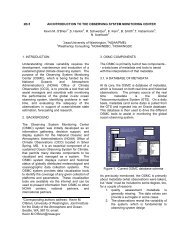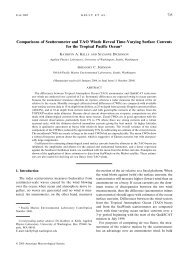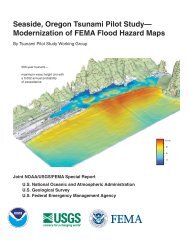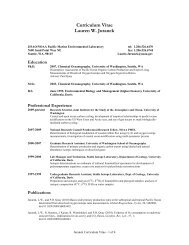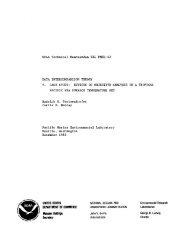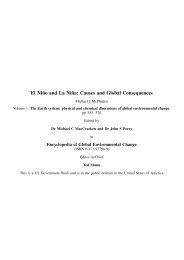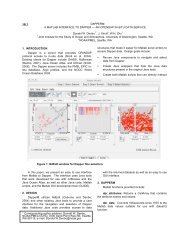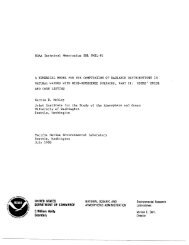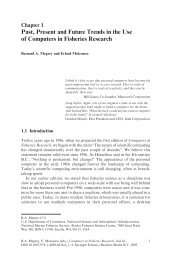Oceanographic conditions on the northern Bering Sea shelf: 1984 ...
Oceanographic conditions on the northern Bering Sea shelf: 1984 ...
Oceanographic conditions on the northern Bering Sea shelf: 1984 ...
Create successful ePaper yourself
Turn your PDF publications into a flip-book with our unique Google optimized e-Paper software.
uoys deployed by Carol Pease off <strong>the</strong> northwest corner of St. Lawrence Island. Despite easterly<br />
and nor<strong>the</strong>asterly winds <strong>the</strong>se buoys drifted eastward and <strong>the</strong>n south through Shpanberg Strait<br />
(pers<strong>on</strong>al communicati<strong>on</strong>).<br />
Flow south of St. Lawrence Island is complex. The current fluctuati<strong>on</strong>s of records from<br />
<strong>the</strong> bight of <strong>the</strong> island were well correlated am<strong>on</strong>g <strong>the</strong>mselves and were generally bettercorrelated<br />
to fluctuati<strong>on</strong>s in Shpanberg Strait than those in Anadyr Strait. This suggests that flow<br />
in Shpanberg Strait and south of St. Lawrence Island are affected by <strong>the</strong> same regi<strong>on</strong>al-scale<br />
forcing.<br />
6. SUMMARY<br />
L<strong>on</strong>g-term mean currents in <strong>Bering</strong>, Anadyr, and Shpanberg Straits were north-setting and<br />
highly rectified. From 85-98% of <strong>the</strong> variance occurred <strong>on</strong> <strong>the</strong> principal axes, which nearly<br />
coincided with <strong>the</strong> local bathymetric axes in <strong>Bering</strong> and Shpanberg Straits and were 20-40·<br />
eastward from <strong>the</strong> bathymetric axis in Anadyr Strait. Scalar and vector mean magnitudes were<br />
greater in <strong>Bering</strong> and Anadyr Straits than in Shpanberg Strait. Currents in <strong>the</strong> regi<strong>on</strong> south of St.<br />
Lawrence Island were weaker and less rectified than currents in <strong>the</strong> straits, although most vector<br />
mean magnitudes were significant. The vector-mean flow was eastward or sou<strong>the</strong>astward at<br />
most moorings.<br />
The data suggest that eastward recirculati<strong>on</strong> of water from Anadyr Strait north and south of<br />
St. Lawrence Island occurred during winter. During autumn, <strong>the</strong> mean magnitudes of <strong>the</strong> currents<br />
in Anadyr and Shpanberg Straits were similar. During winter, <strong>the</strong> scalar mean magnitudes<br />
decreased slightly in both of <strong>the</strong>se straits. Due to frequent flow reversals in Shpanberg Strait, <strong>the</strong><br />
vector mean magnitude <strong>the</strong>re dropped sharply to 21-32% of its autumn value. Flow reversals in<br />
<strong>Bering</strong> Strait during winter coincided with most reversals in Shpanberg Strait, though <strong>the</strong>y were<br />
generally weaker and of shorter durati<strong>on</strong>. The vector mean magnitude in Anadyr Strait showed<br />
<strong>on</strong>ly a small decrease during this period, since flow reversals <strong>the</strong>re were less frequent and of<br />
shorter durati<strong>on</strong> than in <strong>the</strong> o<strong>the</strong>r two straits. The percentage of east-directed currents in Anadyr<br />
Strait did increase during winter, so that <strong>the</strong> vector mean directi<strong>on</strong> was to-IS· east of its autumn<br />
directi<strong>on</strong>. This suggests that water from Anadyr Strait was being recirculated north of St.<br />
Lawrence Island. Eastward flow south of <strong>the</strong> <strong>the</strong> island during decreased flow in Anadyr Strait<br />
suggests recirculati<strong>on</strong> also occurred south of <strong>the</strong> island. During spring, <strong>the</strong> scalar mean magnitude<br />
decreased fur<strong>the</strong>r in Shpanberg Strait but increased in <strong>Bering</strong> and Anadyr Straits, as did <strong>the</strong><br />
vector mean magnitudes.<br />
There was little geographic difference in winds over <strong>the</strong> study regi<strong>on</strong>. Winds were<br />
predominantly from <strong>the</strong> north and nor<strong>the</strong>ast. The vector mean wind, directed toward <strong>the</strong> southwest<br />
at all moorings during autumn, became progressively more south-directed during winter and<br />
spring. Scalar mean magnitudes were similar during autumn and winter but were much lower in<br />
spring. Vector mean magnitudes were highest during winter and lowest during spring, although<br />
<strong>the</strong> differences between autumn and winter magnitudes were less than <strong>the</strong> RMS errors. The<br />
increase was especially small in Shpanberg Strait. Total wind variance was greatest during<br />
autumn at all locati<strong>on</strong>s except <strong>Bering</strong> and Shpanberg Straits. In Anadyr and <strong>Bering</strong> Straits <strong>the</strong><br />
11



